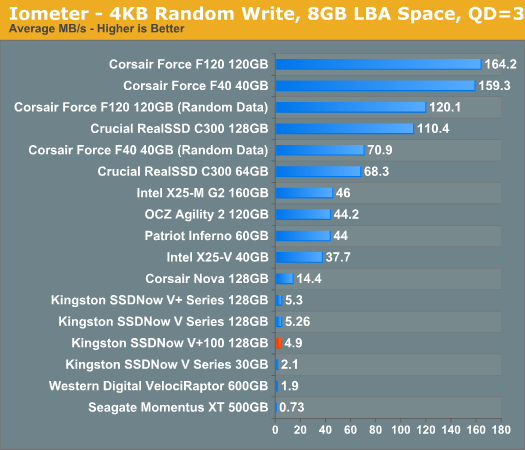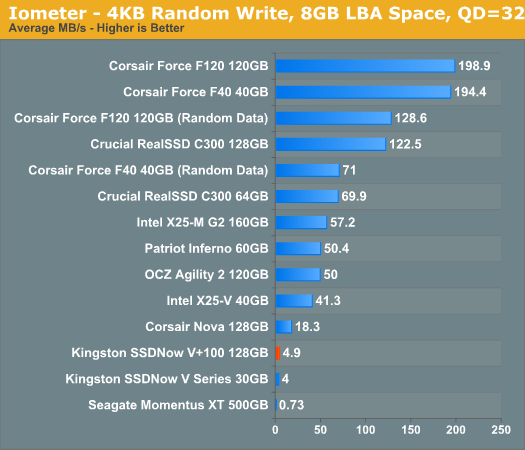Kingston SSDNow V+100 Review
by Anand Lal Shimpi on November 11, 2010 3:05 AM EST- Posted in
- Storage
- SSDs
- Kingston
- SSDNow V+100
Random Read/Write Speed
The four corners of SSD performance are as follows: random read, random write, sequential read and sequential write speed. Random accesses are generally small in size, while sequential accesses tend to be larger and thus we have the four Iometer tests we use in all of our reviews.
Our first test writes 4KB in a completely random pattern over an 8GB space of the drive to simulate the sort of random access that you'd see on an OS drive (even this is more stressful than a normal desktop user would see). I perform three concurrent IOs and run the test for 3 minutes. The results reported are in average MB/s over the entire time. We use both standard pseudo randomly generated data (data is random within a write, but duplicated between writes) for each write as well as fully random data (data is random within a write and random across most writes) to show you both the maximum and minimum performance offered by SandForce based drives in these tests. The average performance of SF drives will likely be somewhere in between the two values for each drive you see in the graphs. For an understanding of why the type of data you're writing matters, read our original SandForce article.

Random write performance has always been the weak spot of Toshiba’s controllers, this latest combination of controller and firmware is no different. Compared to all other SSDs, the Toshiba based SSDNow V+ 100 doesn’t look very good. It’s even slower than the old Indilinx based Corsair Nova. It’s still over 2x the speed of the fastest desktop 3.5” hard drive however, and enough to give you the feel of an SSD for the most part.
Crucial loses a decent amount of performance when going from 128GB to 64GB. The RealSSD C300 drops below even the worst case scenario performance of the Corsair Force F40.
Note that not all SandForce drives are created equal here. If a manufacturer doesn’t meet SandForce’s sales requirements, their drives are capped at a maximum of 50MB/s here. This is the case with the Patriot Inferno, although OCZ’s Agility 2 voluntarily enforces the limit.
Many of you have asked for random write performance at higher queue depths. What I have below is our 4KB random write test performed at a queue depth of 32 instead of 3. While the vast majority of desktop usage models experience queue depths of 0 - 5, higher depths are possible in heavy I/O (and multi-user) workloads:

Kingston's performance doesn't change regardless of queue depth. The SandForce drives either stay the same or get a little faster as they have more requests to parallelize and write sequentially.
Our random read test is similar to the random write test however we lift the 8GB LBA space restriction:

Random read speed is much better, but still not as good as the competition. At 19.7MB/s the SSDNow V+ 100 is a couple of orders of magnitude faster than the 600GB VelociRaptor. The Indilinx based Corsair Nova is even faster however, and nothing can top the RealSSD C300.










96 Comments
View All Comments
Ezekeel - Thursday, December 9, 2010 - link
That is all you have to do to enable TRIM, yes.However, I was talking about optimizations for an SSD (https://wiki.archlinux.org/index.php/SSD#Tips_for_... http://cptl.org/wp/index.php/2010/03/30/tuning-sol... which you all have to do manually while Windows7 afaik does at least some optimizations automatically if you install it on an SSD, like disabling (Super)PreFetch and indexing. Also partition setup with diskpart under Windows automatically takes care of a proper partition alignment while you still have to do it manually under Linux (http://randomtechoutburst.blogspot.com/2010/03/4k-...
ClagMaster - Monday, November 15, 2010 - link
You are right Mr Shimpi that this is confusing and I got a headache.I am not certain what I am going to get if I order a Kingston Drive. Performance is so diverse and the model nomenclature so similar.
I am going to get a OCZVertex 2 or an Intel X-25 G2 instead. I know what I am getting with these brands.
psyside1 - Sunday, November 21, 2010 - link
Hi Anand and all who read this.
Let me start of by saying that i'm new to SSD tech (noob) and i'm starting to learning but there are some things which where not pointed in the reviews as far as i remember.
Heck, even in this review you said that Inferno is somewhat capped to 50 mb/s if i'm not wrong?
So in short,
Where i live i'm limited to 2 models, one is Patriot Inferno and the Other A-DATA S599 with possibly 50K IOPS firmware, as Newegg and Amazon specs confirm?
Now, does that firmware insure i won't get slowdowns (at some points) like the Inferno model in this review? or there is some more about it. if there is, i really got no idea how is that possible same controller, same build? and heck in most of the test the Vertex 2 is still fastest, even faster then the other drives which now share the 50K IOPS firmware, G.Skill Phoenix pro, Corsair Force etc??
i'm mostly interested in SSD which will have good read/write speeds (4K etc) and to be fast during programs/games installation. I got 6 pcs connected in network so that means alot to me, in short does my needs require higher IOPS firmware or i would not notice any difference in performance during installation of big size programs/games.
Also, is it possible to know what revision you get without actually buying the product? is there any info on the package/sticker or part number? the difference in performance i noticed in some reviews was 2x higher random write (4K) speed on the models with OCZ "exclusive firmware. And as far that point goes i'm totally clueless does it really matter at all, and if its not how that that translate in real world usage?
Please answer i don't want to regret my purchase :(
Thanks and sorry for slight off topic :)
psyside1 - Sunday, November 21, 2010 - link
Sorry for double post there is no edit option, actually Madman007 was asking the same i did on the more appropriate way, my English is bad.
tno - Sunday, May 1, 2011 - link
"Remember that NAND is written to at the page level (4KB), but erased at the block level (512 pages)." I think you meant '512 KB.'Gaucherre - Friday, May 6, 2011 - link
Instead of $259, the Kingston V100+ 96GB is available for $119.99 after rebate from Buy.com. This pricing completely changes the value rating from acceptable to outstanding value! The mail-in rebate is rotating from one online store to another. Last month it was at Newegg.com; right now it's at Buy.com. Next month - who knows? Anyway, the cost per Gigabyte when tested here at Anandtech.com was around $2.70. Now it's $1.25 per Gigabyte, and a 96GB drive is large enough for Windows plus quite a few installed programs and games. Pretty good value. Think I just talked myself into ordering one .......